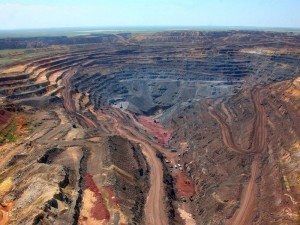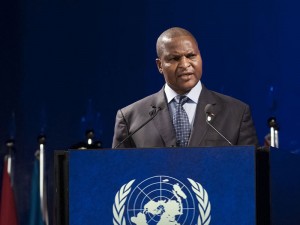“Sustainable development” connotes the processes by which people satisfy their needs and improve their quality of life in the present while safeguarding the ability of future generations to meet their own needs. For most people, a better quality of life means a higher standard of living, usually measured in terms of income level and uses of resources and technology. Inherent in the concept of sustainable development is the principle of equity: in order to achieve economic and environmental goals, social goals – such as universal access to education, health care and economic opportunity – must also be achieved.
The Environment
Below: a classic drawing, not IOSD endorsed but nonetheless interesting
At any level of development, human impact on the environment is a function of population size, per capita consumption and the environmental damage caused by the technology used to produce what is consumed. People in developed countries have the greatest impact on the global environment. The 20 per cent of the world’s people living in the highest income countries are responsible for 86 per cent of total private consumption compared with the poorest 20 per cent, who account for a mere 1.3 per cent. The richest fifth account for 53 per cent of carbon dioxide emissions, the poorest fifth, 3 per cent. A child born in the industrial world adds more to consumption and pollution levels in one lifetime than do 30-50 children born in developing countries. As living standards rise in developing countries, the environmental consequences of population growth will be amplified with ever-increasing numbers of people aspiring, justifiably, to “live better.” Rather than assign blame in the debate over environmental challenges, both current and new consumers need to realize and address the consequences of their levels of consumption.
The difficulty in facing these questions is that the answers are neither simple nor complete. The most obvious environmental impacts are usually local, such as the disappearance of forests and associated watersheds, soil erosion or desertification or the brown haze hovering over cities. Less obvious are phenomena such as the build-up of carbon dioxide in the atmosphere, the global decline of fish catches or the pollution of land and water resources with industrial and hazardous wastes. Further complicating the issue is the lack of data to help researchers determine trends and accurately measure what is happening, a reflection of the relative youth of the environmental sciences, disciplines that require expertise across research areas.
Some trends are already obvious, however, particularly with regard to the three “renewable” resources on which human life depends: land, water and air. Each year, an estimated 5 to 7 million hectares of agricultural lands are lost to accelerating land degradation and rapid urbanization. A sixth of the world’s land area — nearly 2 billion hectares — is now degraded as a result of overgrazing and poor farming practices. Another 16 to 20 million hectares of tropical forests and woodlands are lost each year.
Water is a finite resource. There is no more water on earth now than there was 2,000 years ago when the population was less than 3 per cent of its current size. During this century, while world population has tripled, water withdrawals have increased by over six times. Today, with water scarcity defined as less than 1,000 cubic metres per person per year, 458 million people in 31 countries face water shortages. By 2025, close to 3 billion people in 48 countries will be affected by critical water shortages for all or part of the year.
The pollution and increasing scarcity of renewable fresh water supplies also threaten human health and welfare. An estimated 1.1 billion people were without access to clean drinking water in 1994; 2.8 billion people lacked access to sanitation services. Waterborne diseases infect some 250 million people each year, about 10 million of whom die. The poor are most exposed to fumes and polluted rivers and least able to protect themselves. Of the estimated 2.7 million deaths each year from air pollution, 2.2 million are from indoor pollution and 80 per cent of the victims are rural poor in developing countries.
Today, climate experts worry that continued increases in atmospheric concentrations of CO2 – already 28 per cent higher than pre-industrial levels – could result in sufficient temperature increases to raise sea levels around the world and seriously disrupt agricultural production.
The impact of population growth in rural areas can push communities into unsustainable practices, such as the burning and razing of tropical forests in order to plant crops, over-cropping – and subsequent depletion – of fragile arable land and over-pumping of groundwater.
For the past 50 years, food production has kept ahead of rising demand. Today, in a world where two-thirds of the people depend on rice, wheat and/or maize as their staple food, 80 countries cannot produce enough food to feed their own populations from existing land and water resources. According to FAO, world food production will have to double in order to provide food security for 7.8 billion people expected by 2025.
Compounding the environmental challenges facing us all are the needs of more than roughly 1.3 billion people living in absolute poverty. Without higher standards of living, one-fifth of the world’s people – and their children – will continue to suffer malnutrition, disease and illiteracy.
The gradual slowing of population growth already under way is part of the answer to this environmental dilemma. With slower growth rates, countries will have more time to prepare for the still inevitable, if smaller, population increases to come – time to build schools, dig sewers and lay water pipes.
North-South cooperation is vital to success in ending absolute poverty, a further element in the ongoing environmental dilemma. For those eking out a living, environmentally sound practices are a luxury, not a choice. Developed countries need to develop technologies which minimize damage to natural systems and make these new technologies more widely available to developing countries. For both North and South the ultimate goal should be sustainability in all areas of economic activity, including agriculture, industry, forestry, fisheries, transportation and tourism.
A favourable international economic climate, featuring improved and reliable access to developed country markets, debt reduction and an increased flow of financial resources from North to South, by way of both foreign direct investment and aid for development, is vital to the success of efforts to alleviate poverty.
Education, basic health care – including family planning and reproductive health care — and access to land, credit and employment are all important to poverty alleviation and, therefore, crucial to long-term economic and environmental sustainability. Above all, however, ensuring sustainability will require people to make changes, in both the way they think about their environment and how they live in it. In particular, the high consumption, high-waste lifestyle of the top-earning fifth of the world’s population, most of whom live in the North, cannot continue without imperilling the right of the lowest- earning fifth of the world’s population to satisfy their basic needs.







